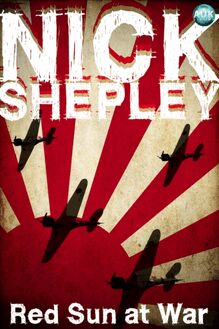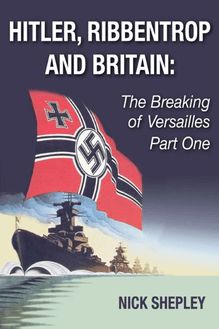Red Sun at War , livre ebook
23
pages
English
Ebooks
2015
Vous pourrez modifier la taille du texte de cet ouvrage
Obtenez un accès à la bibliothèque pour le consulter en ligne En savoir plus
Découvre YouScribe en t'inscrivant gratuitement
Découvre YouScribe en t'inscrivant gratuitement
23
pages
English
Ebooks
2015
Vous pourrez modifier la taille du texte de cet ouvrage
Obtenez un accès à la bibliothèque pour le consulter en ligne En savoir plus
Publié par
Date de parution
07 décembre 2015
Nombre de lectures
0
EAN13
9781781660416
Langue
English
Poids de l'ouvrage
1 Mo
Publié par
Date de parution
07 décembre 2015
Nombre de lectures
0
EAN13
9781781660416
Langue
English
Poids de l'ouvrage
1 Mo
Title Page
RED SUN AT WAR:
PEARL HARBOUR AND JAPAN’S PACIFIC GAMBLE
By
Nick Shepley
Publisher Information
Red Sun At War published in 2012 by
Andrews UK Limited
www.andrewsuk.com
This book is sold subject to the condition that it shall not, by way of trade or otherwise, be lent, resold, hired out or otherwise circulated without the publisher’s prior written consent in any form of binding or cover other than that in which it is published, and without a similar condition being imposed on the subsequent purchaser.
The characters and situations in this book are entirely imaginary and bear no relation to any real person or actual happening.
Copyright © Nick Shepley
The right of Nick Shepley to be identified as author of this book has been asserted in accordance with section 77 and 78 of the Copyrights Designs and Patents Act 1988.
Introduction:
A day of infamy
American military planners were quite prescient in their assessment of Japan’s goals in the Pacific. They could see that for a maritime power like Japan, the sea lanes towards the mid and South Pacific were the key to the Japanese strategy in the region. In late 1941 they expected a strike against their interests somewhere in the region, possibly in the Philippines.
The vast island chain of the Philippines, operated as a de facto protectorate by the USA was the primary target, so the US thought. If Japan captured it they could use bombers flown from its airfields to dominate the shipping lanes and cut the USA off from Asia, isolating Australia and New Zealand. It was this focus and guesswork that blinded the USA to the possibility that there could be another target.
When Japanese Emperor Hirohito authorised Operation Z, it was meant as a pre-emptive strike to cripple the US Pacific Fleet and keep the USA from intervening to protect the Dutch East Indies and their oil fields, Hong Kong and Singapore and their harbours, and Malaya and its rubber plantations.
Japan’s opportunistic 1940 invasion of French Indochina, which followed the fall of France to Germany in Europe was one of the final straws for American strategists, who had been imagining likely military scenarios with Japan for a decade or more.
The long run up to the attack on Pearl Harbour and the rise of Japan as a military power in the Pacific is fully covered in my ebook Red Sun Rising; the combination of frustrated nationalist ambitions and a scramble for resources had led Japan to contemplate a confrontation with America by 1941. The US was not blind to the risk and was anxious to maintain trading rights within China, a market they feared would be closed off by Japan as the Japanese conquest of China, with all it’s resultant horrors and atrocities, continued unabated.
America’s final act in this showdown was to place an oil embargo on Japan, a country completely reliant on external oil imports. This act persuaded any waverers in the Japanese high command that the time to act had arrived and hesitation was no longer an option. Japanese tanks and planes would be running out of fuel soon across China unless the oil wells of the Dutch East Indies were seized. The Japanese task force took ten days to sail to attack the base at Oahu island in the Hawaiian Archipelago, maintaining strict radio silence along the way.
There were similarities in the way the Americans thought about Pearl Harbour to the ways the British thought about Singapore. Both empires were well aware of the threats the Japanese posed to their colonial outposts, and both were convinced of the invulnerability of these fortresses. Both were wrong, with British miscalculations proving to be even more catastrophic than the Americans.
The harbour was one of the most heavily defended locations in the world, with 6 anti battleship gun batteries, 8 cruiser batteries, 12 smaller batteries and 16 anti aircraft gun emplacements. The harbour made for a daunting target, surprise attack or not, which makes the scale of the Japanese successes all the more remarkable.
Not only were strategic assumptions to blame for the lack of intelligence on the coming attack, but there appears to have been an overall complacency on Oahu, an assumption that the Pacific Ocean was protection enough.
Franklin Roosevelt had purposefully sent warships to the Pacific because of his awareness of the danger of growing Japanese naval strength, so this complacency was doubly misplaced.
In this ebook I am going to examine the strategic decisions made by Japan that led to a successful operation, but in strategic terms created a disastrous dilemma that Japan would never be able to solve. I will also look at the global strategic consequences of Japan’s actions for all the other main participants in the war. This volume will focus on the activities of the US and Imperial Japanese Navies, and the next volume will examine their two first major engagements at the Battle of the Coral Sea and the Battle of Midway. A later volume will look at the war the United States Marine Corps fought in the same time period in the Marshall and Solomon Islands and in Papua New Guinea along with the Australian Army.
The Raid
Japan had been contemplating how it would best deal with a threat from the USA since 1920. In his memoirs, Jisaburo Ozawa, Admiral of the Japanese Combined Fleet during the war, said that the strategy had always been to control the sea lanes by occupying the Island of Guam, and to prepare for a decisive sea battle, somewhere near the Philippines, a battle that America would have to be lured into. By 1937, he wrote that the plan for Pacific domination entailed a speedy occupation of US owned Wake and Gilbert Islands in the Pacific, but he also revealed that as early as 1927, Japan’s focus had been on Pearl Harbour. Airborne attack was out of the question in the 1920s because of limitations in technology, but submarine attack was far more plausible. Ozawa wrote that the Imperial Japanese Navy intended to lie in wait of the coast of Oahu for the US fleet and launch a torpedo attack using submarines.
Planning for the attack had begun in early 1941, and the main driving force behind the entire Pacific strategy was Admiral Isoroku Yamamoto, who believed the US Pacific Fleet, now moved from its base in San Diego to Oahu, must be eliminated in a surprise attack.
Yamamoto left the actual execution of the plan in the hands of his subordinate Nagumo, while he stayed behind at Naval Head Quarters on the battleship Nagato, moored in Hiroshima Bay, anxiously awaiting news of the attack. Yamamoto was right to be nervous, the attack on Pearl Harbour was central to the entire Japanese South East Asian strategy, the US Pacific Fleet had to be destroyed in order to make the simultaneous invasion of Malaya, The Philippines and the Dutch East Indies possible, and the Japanese had never mounted an operation like this before. Resupply at sea, navigation with total radio silence and dive bombing and torpedo bombing of this kind had never been done before. The stakes for Japan were enormously high and unless the entire Pacific Fleet was destroyed, the consequences would be devastating.
The case for an air raid had been made the previous year from a rather unlikely source. The Japanese were to model the success that the British Fleet Air Arm had achieved when they sank a large proportion of the Italian Navy at Taranto.
Following Mussolini’s his declaration of war on Britain, his limited foray into Egypt, and his attack on France in support of Hitler, the first priority of the British was to secure the Mediterranean Sea and the routes to India and Arabian oil.
The Royal Navy’s attack on the fleet Regia Maria on November 11th 1940 was the first major demonstration of aircraft carrier power, and it was a major innovation in naval warfare. Prior to the attack on Taranto, the battleship had been the principal naval asset at sea, a vessel of the previous century that evolved primarily from the dreadnought arms races at the dawn of the 20th Century.
These giants were fast approaching obsolescence in the age of the aircraft carrier, as they were principally designed to fight relatively close quarter encounters with other battleships, with the range, number and accuracy of the guns being the deciding factor.
For the loss of two ageing Swordfish aircraft, the British sank one Italian battleship and crippled two more.
The British lost no time in publicising this victory, but even if they hadn’t, the lesson would not have been lost on a host of interested military attaches and spies in Europe and beyond.
The keenest student of Britain’s success was Minoru Genda, a captain in the Imperial Japanese Navy and a close observer of British, Italian and German airpower during 1940. During the Battle of Britain, when Japan was officially neutral and long before the Great Asian War had broken out, Genda made careful note of the performance of Spitfires, Hurricanes and Messerschmitts, satisfying himself that all three aircraft would struggle to outperform the Japanese Mitsubishi Zero.











